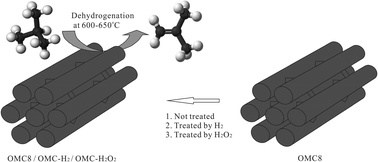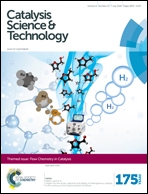Insights into the carbon catalyzed direct dehydrogenation of isobutane by employing modified OMCs†
Abstract
To identify the possible reaction mechanism of carbon-based catalysts for the isobutane direct dehydrogenation (DDH) reaction, a series of modified ordered mesoporous carbons (OMCs) with different surface oxygen contents were prepared and employed as representative catalysts. The OMCs were synthesized by employing SBA-15 as template, and the different oxygen contents were realized by the subsequent oxidation and reduction treatments. According to the characterization results, the treatments have significantly influenced the surface properties, while no obvious change was observed in their pore structure. The differences of surface properties due to the different treatments, and the changes in pore structure and oxygen contents after being used as catalysts, were employed to identify the possible active sites in the carbon catalyzed direct dehydrogenation (DDH) of isobutane. The carbon-based catalysts kept a good stability over a long period of time. The activity was mainly provided by the defects/vacancies on the surface of the carbon materials, and generated coke was also found to be active at a relatively lower level.


 Please wait while we load your content...
Please wait while we load your content...